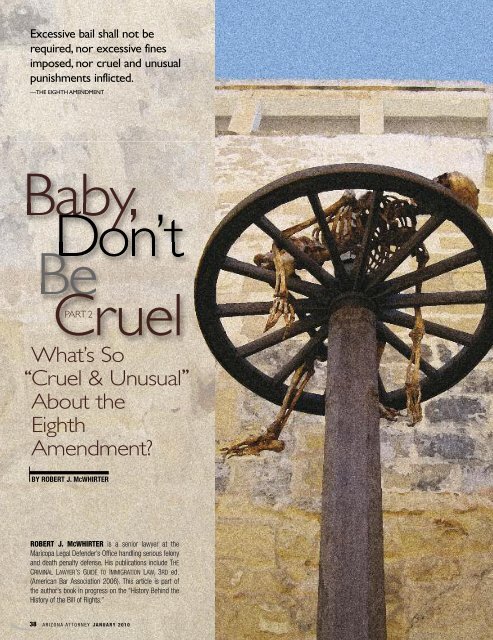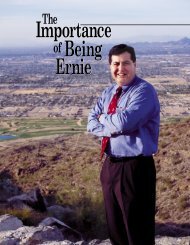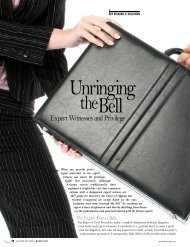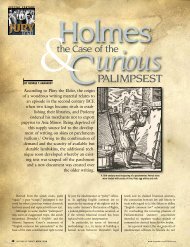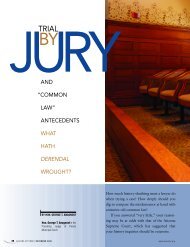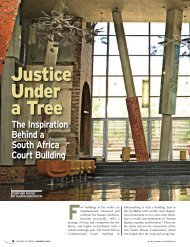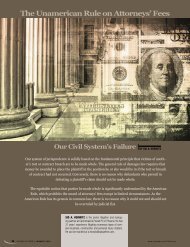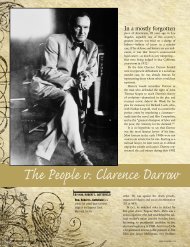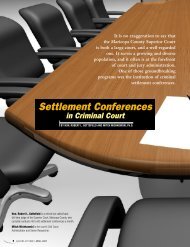What's So Cruel & Unusual About the Eighth Amendment? - Lawyers
What's So Cruel & Unusual About the Eighth Amendment? - Lawyers
What's So Cruel & Unusual About the Eighth Amendment? - Lawyers
Create successful ePaper yourself
Turn your PDF publications into a flip-book with our unique Google optimized e-Paper software.
Excessive bail shall not berequired, nor excessive finesimposed, nor cruel and unusualpunishments inflicted.—THE EIGHTH AMENDMENTBaby,Don’tBe <strong>Cruel</strong>PART 2What’s <strong>So</strong><strong>Cruel</strong> & <strong>Unusual</strong><strong>About</strong> <strong>the</strong><strong>Eighth</strong><strong>Amendment</strong>?‘‘ ’’BY ROBERT J. MCWHIRTERROBERT J. MCWHIRTER is a senior lawyer at <strong>the</strong>Maricopa Legal Defender’s Office handling serious felonyand death penalty defense. His publications include THECRIMINAL LAWYER’S GUIDE TO IMMIGRATION LAW, 3RD ed.(American Bar Association 2006). This article is part of<strong>the</strong> author’s book in progress on <strong>the</strong> “History Behind <strong>the</strong>History of <strong>the</strong> Bill of Rights.”38 A R I Z O N A AT T O R N E Y J A N U A R Y 2 0 1 0
Baby, Don’t Be <strong>Cruel</strong>may have a dungeon for political undesirables and military captives,but <strong>the</strong>y generally did not waste <strong>the</strong> space on commoncriminals. Punishment for <strong>the</strong>m could be scourging, mutilationor, more commonly, death.Medieval people had a different notion of <strong>the</strong> meaning of sufferingthan we do—perhaps because <strong>the</strong>re was more of it in <strong>the</strong>irlives. We generally view suffering as something always to avoid. 1For medieval culture, however, pain had its own benefit. 2 In sufferingone could share in <strong>the</strong> redemptive Passion of Christ. 3 Thisis because body and soul were believed to be one substance. 4Thus, <strong>the</strong> pain of <strong>the</strong> body leads to <strong>the</strong> cleaning of <strong>the</strong> soul. 5 And,who would need redemption more than a criminal/sinner? 6 Formedieval people, <strong>the</strong>refore, scourging, maiming and decapitationwere for <strong>the</strong> condemned’s spiritual good, or, as we would say, hisrehabilitation.Because of <strong>the</strong> redemptive nature of punishment, <strong>the</strong> ritual ofexecution was very important and loaded with spiritual imageryand iconic symbology. 7 In <strong>the</strong> execution ritual, <strong>the</strong> bleeding bodyaccessed God, bringing <strong>the</strong> soul along with it. 8 The key elementswere that <strong>the</strong> criminal (sinner) confesses, atones and suffers steadfastly.9The scaffold was like an altar, with <strong>the</strong> sacrifice being <strong>the</strong> gooddeath. 10 Mounting <strong>the</strong> scaffold ladder compared to <strong>the</strong> <strong>the</strong>ologicalladder of paradise. 11 The condemned was expected to forgivehis executioner, giving grace in <strong>the</strong> expectation of receivinggrace. 12 Each event was not just public, but shared by <strong>the</strong> publicto create reconciliation. In this, <strong>the</strong> sinner/criminal brought <strong>the</strong>community closer to God. 13If <strong>the</strong> ladder to <strong>the</strong> scaffold went missing or was too short,jurists took it as a sign that <strong>the</strong> accused was ei<strong>the</strong>r innocent or hadreceived God’s mercy, ad judicium dei. 14Even <strong>the</strong> type of execution had spiritual significance. 15 Forexample, beheading represented <strong>the</strong> removal of <strong>the</strong> figurativecrown from <strong>the</strong> sinner/criminal’s head. 16 As with o<strong>the</strong>r <strong>the</strong>mes ofmedieval punishment, an allusion to Christ’s “Crown of Thorns”naturally followed. 171. An exception, of course, is <strong>the</strong> almostspiritual experience people seek fromexercise to attain <strong>the</strong> grace of youth andfitness. The descriptions of exercise asbeing good for “body and soul” compareto any purgative a medieval <strong>the</strong>ologiancould divine. Add anorexia and bulimia,and one has to question how different<strong>the</strong> psychology is from medieval foodasceticism. Cf. Olson, Blood Sanction at91, discussing St. Columba of Rieti’sfood asceticism.2. ROSELYNE REY, THEHISTORY OF PAIN 49 (1995)(noting that withinmedieval Christendom,bodily pain possessed anaffirmative meaning as asacrificial offering allowingone to share in Christ’spassion or as purgation togain redemption). But oneexample in imagery is <strong>the</strong> woodcut below by Wolfgang Katzheimerdisplaying a judicial procession of a shacked man to his execution. Afriar with a crucifix attends him and <strong>the</strong> banner reads, “If you bearyour pain patiently/it shall be useful to you/Therefore give yourself to itwilling.” Reproduced in MITCHELL MERBACK, THE THIEF, THE CROSS, ANDTHE WHEEL: PAIN AND THE SPECTACLE OF PUNISHMENT IN MEDIEVAL ANDRENAISSANCE EUROPE 156 (1999) and discussed in Olson, BloodSanction at 88.3. The two “thieves” who died with Christ, depicted hundreds of timessuch as Crucifixion, Andrea Mantegna (1457-1459) or Calvary,Daneil Hopfer (1470-1536), provided <strong>the</strong> example. One shared inChrist’s redemption, and one did not.Crucifixion, Andrea Mantegna (1457-1459)4. Olson, Blood Sanction at 82-89. For Augustine and Aquinas, body andsoul are one substance and thus <strong>the</strong> pain of <strong>the</strong> body leads to cleansingof <strong>the</strong> soul. For Aquinas, <strong>the</strong>n, pain wasa source of inward joy meaning thatscourging, maiming and decapitationwere for <strong>the</strong> condemned’s spiritualgood. Again, if <strong>the</strong> sinner/criminal couldimitate Christ’s suffering, redemptioncould be had. Olson, BloodSanction at 89.5. For Augustine and Aquinasevil cannot exist in <strong>the</strong>absence of good—it is parasiticand requires good to corruptit. See generally Olson,Blood Sanction at 92. Evil isAugustine, Boticelli 1480. suffering (malum peonae) andmoral wrong (malum culpae), but it lacks essence (“esse” inLatin) or form by itself. Olson, Blood Sanction at 94. Evil,<strong>the</strong>refore, cannot triumph over good because to eradicate goodwould mean evil eradicates itself. For this reason, Aquinas states that “Itis impossible to find anything totally evil.” Olson, Blood Sanction at 94.Thus, when <strong>the</strong> human being commitswrong, he acts in “opposition to [his] fairnature” and that evil <strong>the</strong>n causes a “disorder”within a man’s soul. Pain (evendeath) equals penance and restores <strong>the</strong>wrongdoer to “order.”See Olson, Blood Sanction at 103(“By negating <strong>the</strong> negation that is evil,penal pain affirms [<strong>the</strong> sinner/criminal’s]status as a worthy being”).Dore illustration from Paradise LostCalvary, Daniel Hopfer (1470-1536)6. Writing much later Milton explainedevil’s existence as part of a great cosmicbattle - God could havecreated man incapable of evilbut such a mankind wouldnot have been worth <strong>the</strong>effort. See generally JillisaBrittan and Richard Posner,Classic Revisited: PenalTheory in Paradise Lost, 105MICH. L. REV. 1049, 1053(2007) (analyzing God’s punishmentsin Milton’s ParadiseLost identifying retribution forSatan to deter fur<strong>the</strong>r angelicrebellion; rehabilitation anddeterrence for Adam, Eve,and descendants (us) andstrict liability for <strong>the</strong> serpent).7. Olson, Blood Sanction at 81.8. Olson, Blood Sanction at 89. The ritual ofexecution is still important today. See IVANSOLOTAROFF, THE LAST FACT YOU’LL EVERSEE: THE PRIVATE LIFE OF THE AMERICANDEATH PENALTY (2001) (a very interestingchronicle of <strong>the</strong> psychological toll <strong>the</strong> deathpenalty has on executioners as well asdescriptions of <strong>the</strong> death protocolsand mechanisms). Thefilm THE GREEN MILE (WarnerBros. 1999), adapted fromStephen King’s 1996 novel,starring Tom Hanks andMichael Clarke Duncan, shows<strong>the</strong> ritual in numerous scenes.St. Thomas Acquinas9. Olson, Blood Sanction at112. The movie DEAD MANWALKING (Gramercy PicturesU.S. 1995) alsoshows <strong>the</strong> ritual ofJohn Coffey (Duncan) being escorted tohis execution by Edgecomb (Hanks) andBrutus Howell (David Morse).death in prisons as a prison guard declares “dead manwalking” during <strong>the</strong> film. The film adapts Sister HelenPrejean’s nonfiction book of <strong>the</strong> same name, which tells<strong>the</strong> story of Sister Prejean (Susan Sarandon), whoestablishes a special relationship with Mat<strong>the</strong>wPoncelet, a consolidation of two death-row prisoners(Sean Penn). As with <strong>the</strong> mediaeval rituals, <strong>the</strong> film’s climaxis Poncelet’s confession and atonement.Death by Electrocution: The word “electrocution” comes from “electric” and“execution.”The Death: The executioners:shave <strong>the</strong> condemned’shead and legs; strap him to achair; place a natural spongewith saline solution on his head;and attach an electrode to <strong>the</strong>head and ano<strong>the</strong>r to his leg,which closes <strong>the</strong> circuit. Death“Old Sparky” (Arkansas)occurs when <strong>the</strong> executionerspass electrodes through his body in various cycles (differing in voltage andduration) of alternating current, fatally damaging internalorgans, including <strong>the</strong> brain. Rosenberg &Rosenberg at 1172; Khan & Leventhal at 848. Severalstates still have electrocution as <strong>the</strong>ir primary meansof execution or allow <strong>the</strong> condemned to choose it.The Chair: A dentist, Alfred P. <strong>So</strong>uthwick, conceivedof <strong>the</strong> Electric Chair, patterning it off his dentist’schair after he saw an intoxicated man die ontouching an exposed electric terminal.Nicknames for <strong>the</strong> Chair include Sizzlin’ Sally, Old40 A R I Z O N A AT T O R N E Y J A N U A R Y 2 0 1 0w w w. m y a z b a r. o r g / A Z A t t o r n e y
THE EIGHTH AMENDMENTThe common criminalwould be executed with “TheBreaking Wheel,” a torturouscapital punishment devicecausing death by cudgeling(i.e., blunt force trauma withbone-breaking force). 18 Thewheel worked systematicallyto break all <strong>the</strong> bones on all<strong>the</strong> condemned’s limbs longbefore death happened. 19 Butthis manner of execution,which we would today callinhumane, had great spiritualsignificance. The wheel wasalso called “<strong>the</strong> Ca<strong>the</strong>rineWheel” because SaintCa<strong>the</strong>rine of Alexandria wasSmokey, Old Sparky, YellowMama and Gruesome Gertie.Gruesome Gertie (<strong>the</strong> Louisianaelectric chair) was in <strong>the</strong> movieMONSTER’S BALL (Lions GateFilms 2001). The electric chairwas first used in 1890 after <strong>the</strong>Supreme Court approved its constitutionality.In re Kemmler, 136U.S. 436 (1890). Andy Warholmade it a statement of politicalart in Orange Disaster, 1963. Andy Warhol, Orange Disaster, 1963The Chair and <strong>the</strong> War of Currents: Harold P. Brownworked for Thomas Edison to make <strong>the</strong> first electric chair, whichbecame a skirmish in <strong>the</strong> War of Currents between Edison, proponentand seller of direct current (DC), and GeorgeWestinghouse, proponent and seller of alternating current (AC).Edison wanted <strong>the</strong> electric chair to function on Westinghouse’sAC to claim it was more dangerous. (In reality, <strong>the</strong> difference at<strong>the</strong> required amperage is marginal). Edison killed animals withAC for <strong>the</strong> press to associate it with electrical death. Edison eventried to make up <strong>the</strong> verb “to Westinghouse” for execution.Westinghouse, who knew what Edison was up to, refused to sellEdison an AC generator. Edison had to pretend he was a universityand had Westinghouse’s AC generator shipped to New Yorkthrough <strong>So</strong>uth America. On <strong>the</strong> o<strong>the</strong>r side, Westinghouse surreptitiouslyfinanced <strong>the</strong> defense of <strong>the</strong> first person to be sentencedto death by electric chair so as not to give his AC a bad name.After <strong>the</strong> first execution went sloppily, Westinghouse commented,“They would have done better using an axe.” See generallySTUART BANNER, THE DEATH PENALTY: AN AMERICAN HISTORY(2002); see also Robert J. Cottrol, Finality With Ambivalence: TheAmerican Death Penalty’s Uneasy History, 56 STAN. L. REV. 1641(2004) (Reviewing STUART BANNER, THE DEATH PENALTY: ANAMERICAN HISTORY (2002)).The Chair and DoubleJeopardy: Despite its seemingtechnological foundation,<strong>the</strong> electric chair has producedmessy results. In Stateof Louisiana ex rel. Francis v.Resweber, 329 U.S. 459(1947), <strong>the</strong> Supreme Cour<strong>the</strong>ld that a second attempt toelectrocute Willie Francisafter <strong>the</strong> first time failed didnot violate <strong>the</strong> FifthWillie Francis with his fingers crossedfor <strong>the</strong> good luck that <strong>the</strong> Supreme Courtwill not give him.<strong>Amendment</strong>’s double jeopardy clause or <strong>the</strong> <strong>Eighth</strong> <strong>Amendment</strong>’scruel and unusual punishment clause. They electrocuted Francisagain in 1947, this time killing him. See GILBERT KING, THEEXECUTION OF WILLIE FRANCIS: RACE, MURDER, AND THE SEARCH FORJUSTICE IN THE AMERICAN SOUTH (2008); Schwartz at 790.10. Olson, Blood Sanction at 103. St. Ca<strong>the</strong>rine of Siena recordsparticipating in an execution ritual. See Olson, Blood Sanction at121-24. In 1375 Ca<strong>the</strong>rine helped prepare a Nicolas Tuldo for agood death. He was sentenced to death in Siena for speakingagainst <strong>the</strong> city’s magistrates. “He was so comforted and consoledthat he confessed his sins and prepared himself very well”hearing Mass and taking communion. “His will was united andsubmissive to <strong>the</strong> will of God,” and he mounted <strong>the</strong> scaffold as a“peaceable lamb” … “called holy <strong>the</strong> place of justice [i.e., <strong>the</strong>gallows]!” She placed his neck on <strong>the</strong> block and when <strong>the</strong> bladestruck him said ‘Gesù!’ and ‘Caterina!’ She <strong>the</strong>n caught his headand her eyes “fixed on divine Goodness.” Christ “received Nicolas’blood into His own.” The crowd participated in <strong>the</strong> ritual too and“marveled” at what happened.Although St. Ca<strong>the</strong>rine writes that Nicolas receivedCommunion, medieval authorities and <strong>the</strong> church often denied <strong>the</strong>condemned communion because Christ was thought to remainpresent in <strong>the</strong> body for three days and executioners did not wantto send Christ to <strong>the</strong> gallows. Olson, Blood Sanction at 113.St. Ca<strong>the</strong>rine of Siena by Domenico Beccafumi, c. 1515. St. Ca<strong>the</strong>rine, O.P. (1347-12. Olson at116-17.14. Olson Blood Sanction at 111. Also, a woman couldintercede for <strong>the</strong> condemned by asking him to marry her.19. Breakingon <strong>the</strong> wheelmeant that<strong>the</strong> condemned would have everymajor bone in his body broken severaltimes per limb.Depending on <strong>the</strong> device this couldmean he was attached to a wheel anda large hammer or iron bar would break <strong>the</strong> bones as <strong>the</strong> executionerswould slowly turn <strong>the</strong> wheel. Then his executionerswove his arms and legs into <strong>the</strong> spokes of <strong>the</strong> wheel andmounted it on a pole where <strong>the</strong>y left him to die from exposureand hungry birds, which could takedays. <strong>So</strong>metimes <strong>the</strong> condemnedreceived mercy when his executionerstruck him on <strong>the</strong> chest andDespenser’s large phallus is because he was Edward II’s reputed homosexual lover, taking<strong>the</strong> male role. In a variation of <strong>the</strong> traitor’s death, <strong>the</strong>y also castrated him. Edward II wasreportedly killed with a hot iron up his rectum. Peter Hanly played Edward II in <strong>the</strong> movieBRAVEHEART. In <strong>the</strong> movie, <strong>the</strong> old king Edward I throws Edward II’s gay lover out<strong>the</strong> castle window. This was probably not Despenser, but an earlier lover calledPeter Giles, whom some of Edward II’s o<strong>the</strong>r courtesans had executed.stomach, blows known as coupsde grâce (French for “blow ofmercy”), causing death.Giotto: The Seven Virtues—Lady Justice (1306)80) was a Dominican lay affiliate, scholastic philosopher and <strong>the</strong>ologian. this sense.Wheel of FortuneThe wheel was also an important cultural <strong>the</strong>me in medievalEurope in <strong>the</strong> concept of <strong>the</strong> Wheel of Fortune or Rota Fortuna.God’s Grace put you at <strong>the</strong> top one day, but <strong>the</strong> earth is a transitoryplace and <strong>the</strong> next day you could be one <strong>the</strong> wheel’s bottom or brokenby it, as Chaucer notes:“And thus does Fortune’s wheel turn treacherouslyAnd out of happiness bring men to sorrow.” Geoffrey Chaucer, TheCanterbury Tales, The Monk’s Tale.Also, William Shakespeare in Hamlet wrote of <strong>the</strong> “slings andarrows of outrageous fortune” and, of fortune personified, to “breakall <strong>the</strong> spokes and fellies from her wheel.” See also Henry V, Act 3Scene VI, and King Lear at <strong>the</strong> end of Act II, Scene 2: “Fortune,good night, smile once more; turn thy wheel!”Execution of Despenser, from a manuscript of Froissart17. Jesus Carrying <strong>the</strong> Cross with <strong>the</strong> Crown of Thorns, by El Greco 158018. The breakingwheel11. Olson, Blood Sanction at 118-19. Cf. The Ladder of Paradise (12th-century), showingdemons and angels vying for monks, and Crucifixion of Christ, by Albrecht Altdorfer (1526),showing <strong>the</strong> <strong>the</strong>matic ladder associatedwith Christ, with The Execution ofHugh Despenser <strong>the</strong> Younger from<strong>the</strong> Froissart manuscript. Though not acommon criminal, Despenser’s executionexemplifies <strong>the</strong> expected gooddeath. In 1326 Despenser was convictedof treason after Queen Isabella’s andRoger Mortimer’s successful revoltagainst <strong>the</strong> English king, Edward II.Although Despenser was “drawnthrough <strong>the</strong> whole city of Herford, <strong>the</strong>n hanged,<strong>the</strong>n beheaded,” he “humbly and patiently sufferedanything andprofessed publiclyto all tha<strong>the</strong> had meritedworse, and heoften asked pardonof thosewho stood nearand <strong>the</strong> passerbys.”Quoted inOlson, BloodSanction at115.13. MICHEL FOUCAULT, DISCIPLINE AND PUNISH: THE BIRTH OF THE PRISON 46 (1979),discussed in Olson, Blood Sanction at 127.15. Generally, beheading was for <strong>the</strong> upper nobility, hangingfor <strong>the</strong> masses, and burning at <strong>the</strong> stake for heretics orthose who had committed particularly heinous crimes.Olson, Blood Sanction at 117.16. Olson, Blood Sanction at 117 (citing SAMUEL EDGERTON,PICTURES AND PUNISHMENT: ART AND CRIMINAL PROSECUTIONDURING THE FLORENTINE RENAISSANCE 126 (1985)). For example,Giotto’s JUSTICE is an enthroned woman with a crownholding <strong>the</strong> scales of justice. An angel brandishes a swordupon <strong>the</strong> head of a seated figure who wears a crown whileano<strong>the</strong>r angel reaches to place a crown upon ano<strong>the</strong>r seatedfigure.Personified is Distributive Justice who, according toAquinas, “gives to each what hisrank deserves … good and bad,honour and shame.”Of course, it would be hardto argue that <strong>the</strong> modern gameshow Wheel of Fortune retainsThe Ladder of Paradise (12th century)☛☛Crucifixion of Christ, by Albrecht Altdorfer (1526)w w w. m y a z b a r. o r g / A Z A t t o r n e y J A N U A R Y 2 0 1 0 A R I Z O N A AT T O R N E Y 41
Baby, Don’t Be <strong>Cruel</strong>to be executed on one. 1 Medieval paintings of Christ’s Passiondepict <strong>the</strong> wheel in <strong>the</strong> scene, in an analogy to Christ’s crucifixion,despite <strong>the</strong> fact <strong>the</strong>re is no biblical reference to one. 2The disturbing implication to this spiritual focus of redemptivepunishment, however, is that it can be all too tolerant of <strong>the</strong> executionof an innocent. 3 Indeed, if <strong>the</strong> goal of <strong>the</strong> death ritual is<strong>the</strong> reconciliation of <strong>the</strong> community, who better than an innocentperson suffering in imitation of Christ, <strong>the</strong> true innocent sacrificiallamb? 4 After all, we are all guilty of something. Thus, even ifa person did not commit <strong>the</strong> crime, he was still a sinner like everyoneelse and would have an easier path to heaven. 5 And <strong>the</strong> communityis reconciled none<strong>the</strong>less. The problem, of course, is itTHE EIGHTH AMENDMENTthat a sacrificial lamb becomes a scapegoat. 6Medieval public executions probably did serve deterrence tocrime as well as a spiritual value. 7 But <strong>the</strong> jurists at <strong>the</strong> time werevery clear that deterrence was not <strong>the</strong> focus of <strong>the</strong>ir justifications.8 The executions were bloody and public, but infrequent.This contrasts with our age of frequent executions behind sealedprison walls. 9Kings and DeathMuch of <strong>the</strong> history of <strong>the</strong> English monarchy involved kingswanting to get control of <strong>the</strong> death business. From Henry II’sattempts to prosecute “crimonious clerks” 10 to Henry VIII’s useSt. Ca<strong>the</strong>rine of Alexandria, Caravaggio, c. 15981. Ca<strong>the</strong>rine visited RomanEmperor Maxentius to convincehim to stop persecuting Christians.Instead, <strong>the</strong> Emperor tried toseduce her, and when he failed heordered her condemned on <strong>the</strong>breaking wheel. When Ca<strong>the</strong>rinetouched it, <strong>the</strong> wheel broke, so <strong>the</strong>Emperor had her beheaded.St. Ca<strong>the</strong>rine was one of <strong>the</strong> saints that Joan of Arcspeaks to in <strong>the</strong> movie THE MESSENGER: THE STORY OFJOAN OF ARC (Columbia Pictures 1999).Also, Santa Catalina (Catalina) Island in California anda lunar crater are named for this St. Ca<strong>the</strong>rine.Michelangelo, detail of TheLast Judgement (1534-41),with St. Ca<strong>the</strong>rine holdinga broken wheel☛Ca<strong>the</strong>rine Wheelwas also an English“alternative rock”band from 1990 to2000.2. For example, The Procession to Calvary, Pieter Bruegel (1564), has a Ca<strong>the</strong>rine Wheel on<strong>the</strong> far right.3. Our age,with its limitedspiritual focus,can be just astolerant ofinnocents executed.Forexample,Cassell states,“Perhaps <strong>the</strong>most successfulrhetoricalattack on <strong>the</strong>death penaltyhas been <strong>the</strong>claim thatinnocent personshave been convicted of, and even executed for, capital offenses.” Paul G.Cassell, In Defense of <strong>the</strong> Death Penalty, in DEBATING THE DEATH PENALTY: SHOULD AMERICA HAVECAPITAL PUNISHMENT? 183, 205 (Hugo Adam Bedau & Paul G. Cassell eds., 2004). As of February2008, <strong>the</strong> Innocence Project has exonerated more than 213death-row inmates.www.innocenceproject.org.☛Dante and His Poem, DomenicoDi Michelino 1465.4. The sacrifice of <strong>the</strong> innocencelamb is metaphor forredemption and is a very oldChristian <strong>the</strong>me evident in <strong>the</strong>books and movie THECHRONICLES OF NARNIA.☛THE CHRONICLES OF NARNIA(Buena Vista, 2005)5. Thus, avoiding <strong>the</strong> extension of <strong>the</strong> earthilyblood sanction in hell. This was <strong>the</strong> premise ofDante’s Divine Comedy. Olson, Blood Sanction at88. The damned are blind to <strong>the</strong>ir own vice andthus continue to pursue it—<strong>the</strong> sin itself causes<strong>the</strong> suffering, not God. Olson Blood Sanction at100-01, 126 (demonstrating how Dante illustrates<strong>the</strong> cultural <strong>the</strong>me of <strong>the</strong> purpose of punishment).Therefore Dante’s Hell is not about retribution or“an eye for eye” because <strong>the</strong> punishments ariseDante and His Poem, Domenico di Michelino 1465 from <strong>the</strong> crime/sin itself, not from <strong>the</strong> damage.See WHAT DREAMS MAY COME(PolyGram 1998), starring Robin Williams,Cuba Gooding Jr., and Annabella Sciorra fora modern rendition of Dante’s <strong>the</strong>mes.Dante’s punishments are symbolic (e.g., <strong>the</strong>The Violent, tortured in <strong>the</strong> Neutrals, those who refused to take sidesRain of Fire, Gustave Doréduring times of moral crisis, run forever under a symbolic blank banner).In Purgatory <strong>the</strong> punishments are generally <strong>the</strong> same as HellThe Severed head of Bertrandde Born speaks, Gustave Dorébut <strong>the</strong> souls are aware of <strong>the</strong>ir sin and <strong>the</strong>ir penance. Olson, BloodSanction at 102. Thus, Purgatory is about payment of debt and <strong>the</strong> chance to gain Grace. Olson, Blood Sanction at 99.Picking up on <strong>the</strong> <strong>the</strong>ology of St. Thomas Aquinas that <strong>the</strong> soul and body are one essence, Dante notes that sointense is <strong>the</strong> soul’s need of <strong>the</strong> body that when deprived of it <strong>the</strong> soul “imprints” its body in <strong>the</strong> air. Olson, BloodSanction at 100. This “imprinting” of <strong>the</strong> soul idea is a nice plot device allowing Dante to talk to <strong>the</strong> souls during his guidedtour of Hell and Purgatory. THE MATRIX (Warner Bros. 1999) uses <strong>the</strong> same plot device, calling it “residual self-imaging,”explaining why <strong>the</strong> characters look <strong>the</strong> same in both <strong>the</strong> “real” and <strong>the</strong> computer generated Matrix worlds.6. The priests of ancient Israel would drive a goat into <strong>the</strong> wilderness as part of <strong>the</strong> Day of Atonement ceremonies (YomKippur) after ceremonially heaping <strong>the</strong> sins of <strong>the</strong> community on it. Leviticus 16 describes <strong>the</strong> practice, which foreshadowed<strong>the</strong> Christian <strong>the</strong>me of <strong>the</strong> Sacrificial Lamb of Christ. Today, to “scapegoat” is more widely used as a metaphor meaning toblame someone or a group for misfortunes usually to distract from <strong>the</strong> real problem.☛☛7. See Ambrogio Lorenzetti’s fresco The Allegory of Good Government in <strong>the</strong> PalazzoPublico (1328 A.D.) in Siena showing awinged and draped woman, “Securitas,” flyingover <strong>the</strong> town holding a gallows with a deadman. Noted in Olsen, Blood Sanction at 72.8. Olson, Blood Sanction at 70-81. ForAquinas <strong>the</strong> benefit of removing a “corruptlimb” from society outweighed <strong>the</strong> evil ofphysical punishment to <strong>the</strong> sinner/criminal.Olson, Blood Sanction at 97. Again, this is in <strong>the</strong> contextof a society that lacked <strong>the</strong> alternative of prison.9. “[E]xecutions which had once been frequent publicspectacles became infrequent private affairs. Themanner of inflicting death changed, and <strong>the</strong> horrors of<strong>the</strong> punishment were, <strong>the</strong>refore, somewhat diminishedA modern (semi private)death chamberin <strong>the</strong> minds of <strong>the</strong> general public.” Furman v. Georgia, 408 U.S. 238, 340(1972) (Marshall, J., concurring).See also Nicholas Levi, Veil of Secrecy: Public Executions, Limitations onReporting Capital Punishment, and <strong>the</strong> Content-Based Nature of PrivateExecution Laws, 55 FED. COMM. L.J. 131, 134-35 (2002).For a study of modern punishment in general see Eva S. Nilsen, Decency,Dignity and Desert: Restoring Ideals of Humane Punishment to ConstitutionalDiscourse, 41 U.C. DAVIS L. REV. 111-175 (2007). Modern punishmentinvolves longer and meaner sentences, and prison conditions that are moredegrading and dangerous; <strong>the</strong>re also is a lack meaningful post-release programs.Moreover, <strong>the</strong> Supreme Court’s formalistic reading of <strong>the</strong> <strong>Eighth</strong><strong>Amendment</strong> has produced “a legal and moral blindness” to <strong>the</strong> constitutionalproblems of modern punishment.Court of King’s Bench, c. 1460,showing a chain gang at <strong>the</strong> bottomand a jury to <strong>the</strong> left with judges,lawyers and clerks. Inner TempleLibrary at www.innertemplelibrary.org.uk/welcome.htm.10. ANTONIA FRASER, THE LIVES OF THEKINGS AND QUEENS OF ENGLAND, 40-41.42 A R I Z O N A AT T O R N E Y J A N U A R Y 2 0 1 0w w w. m y a z b a r. o r g / A Z A t t o r n e y
Baby, Don’t Be <strong>Cruel</strong>of <strong>the</strong> death penalty to become <strong>the</strong> English Pope as well as king, 1death became a useful state tool. 2Indeed, <strong>the</strong> law of homicide developed as kings got into <strong>the</strong>death business. In <strong>the</strong> 16th century, under <strong>the</strong> Tudors, <strong>the</strong> conceptof “benefit of clergy” passed into common law and produced<strong>the</strong> outlines of modern homicide law. 3 “Murder,” forinstance, became a homicide that did not qualify for “benefit ofclergy” (something akin to what we today would callmanslaughter or a justifiable homicide). 4At this point <strong>the</strong> use of torture as punishment and as aninvestigative tool came into question as being “cruel.” 5 Theseobjections to torture in criminal procedure, however, cutagainst longstanding practices.For example, common law courts had long used a torturecalled peine forte et dure (Law French for “hard and forcefulpunishment”) to get defendants to enter a plea submitting to<strong>the</strong> court’s jurisdiction. 6 Common law courts originally consideredthat <strong>the</strong>y lacked jurisdiction over a defendant until heTHE EIGHTH AMENDMENTsubmitted to it—a holdover from when <strong>the</strong> parties couldchoose from o<strong>the</strong>r types of trials, such as ordeal, battle orcompurgation.After <strong>the</strong>se o<strong>the</strong>r forums passed into history and <strong>the</strong> Crowngained more of an interest in providing a system of criminal justice,<strong>the</strong> king’s courts needed a way to assert jurisdiction. 7Thus, when a defendant stood mute and refused to plead, <strong>the</strong>court would order him to a “press room,” where stones wereplaced on his or her chest until he submitted to jury trial withhis plea. 8 If not, <strong>the</strong>y added weight until he suffocated. 9The simple expedient of entering a plea for <strong>the</strong> defendanteluded <strong>the</strong> common law until 1772, when Parliament made amute plea equivalent to a “guilty” plea. In 1827, Parliamentchanged a mute plea to “not guilty,” <strong>the</strong> modern practice. 10The Coming of <strong>the</strong> English Bill of RightsThe 1600s were a tumultuous time in English history.In 1603, <strong>the</strong> last of <strong>the</strong> Tudors, Elizabeth I, died, and <strong>the</strong>4. Lanham at 90. The courts, not parliament, firstdefined manslaughter. Kaye at 369. Over time <strong>the</strong>older definitions of serious and simple homicidebecame murder and manslaughter. Green, Homicideat 472-73, 473- 491. These more formal definitionsreplaced <strong>the</strong> informal rough justice of <strong>the</strong> jury system.Thus, though conviction rate increased from <strong>the</strong> 14th8. After Henry VIII, pleading inreligious trials became all <strong>the</strong>more pertinent. In 1586 SaintMargaret Cli<strong>the</strong>row refused toplead to <strong>the</strong> charge of harboringCatholic priests. She did this toavoid a trial where her childrencentury, <strong>the</strong> condemnation rate remained <strong>the</strong> same, would have to testify. They laidCoke Justice Marshall Henry VII Blackstone showing that <strong>the</strong> law used <strong>the</strong> manslaughter/murder her on a sharp rock, put a door Giles Corey pressed to death during <strong>the</strong> Salem Witch Trials.1. In <strong>the</strong> 16th century during Henry VIII’s reign, <strong>the</strong>re were an estimated72,000 executions, LEVY at 232, a staggering number for a nation <strong>the</strong> size ofEngland at <strong>the</strong> time.Executing and Punishing <strong>the</strong> Insane: Henry VIII passed a law providingdistinction to replace <strong>the</strong> old jury justice system.Green, Homicide at 493; Kaye at 365. The penalty formanslaughter was imprisonment not more than oneyear, and branding. Green, Homicide at 483, 488.on her and loaded it with rocks and stones, killing her within 15 minutes. Thiswas Mar. 25, 1586, a Good Friday. THE CATHOLIC ENCYCLOPEDIA, www.newadvent.org/ca<strong>the</strong>n/04059b.htm.This mix of torture as pretrial coercion andthat a man convicted of treason should still be executed even if he becamepunishment again showing <strong>the</strong> connection5. In 1583 Robert Beale condemned “<strong>the</strong> racking ofinsane. 33 Hen. VIII, ch. 20 cited in Ford v. Wainwright, 477 U.S. 399, n.1between <strong>the</strong> Fifth andgrievous offenders, as being cruel, barbarous, contrary(1986). The common law writers uniformly condemned <strong>the</strong> law, with Coke writingthat <strong>the</strong> “cruel and inhumane Law lived not long, but was repealed, for inplayed out in America<strong>Eighth</strong> <strong>Amendment</strong>s,to law, and unto <strong>the</strong> liberty of English subjects.”Quoted in LEVY at 232. Again, as noted earlier, <strong>the</strong>rethat point also it was against <strong>the</strong> Common Law.” 3 E. COKE, INSTITUTES 6 (6thduring <strong>the</strong> Salem Witchis a close relationship between <strong>the</strong> Fifth <strong>Amendment</strong>’sed. 1680). Quoted in Ford at 477 U.S. at 407-08.trials. Giles Corey diedprohibition on coerced statements and <strong>the</strong> EightOn <strong>the</strong> topic of punishing <strong>the</strong> insane in general, Coke wrote “[B]y intendmentof Law <strong>the</strong> execution of <strong>the</strong> offender is for example, … but so it is noton Sept. 19, 1692,from peine forte et dure<strong>Amendment</strong>’s prohibition on cruel and unusual punishments.See Rumann, 665-66, 668 and n.45, 679.when a mad man is executed, but should be a miserable spectacle, bothafter he refused toagainst Law, and of extreme inhumanity and cruelty, and can be no example toSt. Margaret Cli<strong>the</strong>row enter a plea in <strong>the</strong> judicialo<strong>the</strong>rs.” Id., quoted in Ford at 477 U.S. at 407-08, also citing 1 M. HALE,proceeding. According to legend, his lastPLEAS OF THE CROWN 35 (1736); 1 W. HAWKINS, PLEAS OF THE CROWN 2 (7th ed.words as he was being crushed were “more1795); Hawles, Remarks on <strong>the</strong> Trial of Mr. Charles Bateman, 11 How.St.Tr.weight,” and he was thought to be dead as <strong>the</strong>THE CRUCIBLE (20th Century Fox 1996)474, 477 (1685).Blackstone followed less than a century later: “[I]diots and lunatics are notchargeable for <strong>the</strong>ir own acts, if committed when under <strong>the</strong>se incapacities: no,weight was applied. Arthur Miller’s political drama THE CRUCIBLE has Giles Coreyrefuse to answer “aye or nay” to witchcraft, but <strong>the</strong> movie version has him killedfor refusing to reveal a source of information.not even for treason itself. Also, if a man in his sound memory commits a capitaloffence, and before arraignment for it, he becomes mad, he ought not to be9. Such a death did, however, allow a defendant to avoid a conviction and subsequentforfeiture of property. If convicted, <strong>the</strong> king got <strong>the</strong> condemned’s propertyarraigned for it: because he is not able to plead to it with that advice and cautionthat he ought. And if, after he has pleaded, <strong>the</strong> prisoner becomes mad, heThe Rack(i.e., it was “escheated” to <strong>the</strong> Crown) leaving <strong>the</strong> defendant’s heirs nothing.6. See generally Andrea McKenzie, This Death <strong>So</strong>me The U.S. Constitution prohibits making a person “dead in law” (i.e., loss ofshall not be tried: for how can he make his defense? If, after he be tried andStrong and Stout Hearted Man Doth Choose”: The civil and citizen rights) and “corruption of blood” (i.e., preventing heirs for receiving<strong>the</strong> condemned’s property and rights) in three prohibitions against Bills offound guilty, he loses his senses before judgment, judgment shall not be pronounced;and if, after judgment, he becomes of nonsane memory, executionPractice of Peine Forte Et Dure in Seventeenth- andEighteenth-Century England,Attainder:shall be stayed: for peradventure, says <strong>the</strong> humanity of <strong>the</strong> English law, had23 LAW & HIST. REV. 279☛ “No Bill of Attainder … shall be passed” – Article I, § 9, cl. 3<strong>the</strong> prisoner been of sound memory, he might have alleged something in stay(2005). See also Olson, Blood☛ “No State shall … pass any Bill of Attainder” – Article I, §of judgment or execution.” 4 W. BLACKSTONE, COMMENTARIES 24- 25.Sanction at 111 for example of10, cl. 1Justice Thurgood Marshall in 1986, writing for <strong>the</strong> U.S. Supreme Court inRichard II pardoning a man☛ “The Congress shall have Power to declare <strong>the</strong> PunishmentFord v. Wainwright, 477 U.S. 399 (1986), finally found <strong>the</strong> practice unconstitutional.after enduring peine forte etof Treason, but no Attainder of Treason shall work Corruption ofdure.Blood, or Forfeiture except during <strong>the</strong> Life of <strong>the</strong> Person attainted”2. “Capital punishment” comes from <strong>the</strong> Latin word capitalis (from caput, head) 7. See LEVY at 233.– Article III, § 3, cl. 2to describe that which related to life. They used <strong>the</strong> neuter form of this adjective,i.e., capitale, substantively to denominate death, or loss of all civil rights, <strong>the</strong> same as execution by<strong>the</strong> Origins of <strong>the</strong> Bill of Attainder Clause, 18 ST. THOMAS L. REV.Peine forte et dure is notSee Claus at 149-52. Also Jacob Reynolds, The Rule of Law andand banishment imposed by public authority in consequence of crime. THE crushing. In ancient times177 (2005).CATHOLIC ENCYCLOPEDIA www.newadvent.org/ca<strong>the</strong>n/12565a.htm.<strong>the</strong> Carthaginians executed3. See Green, Homicide at 415, 472-76 on benefit of clergy affecting developmentof homicide law; also at 480 n.241 on <strong>the</strong> power struggle with Henry than 4,000 years of recordedstates, “Failure to Enter a Plea. If a defendant refuses to enter apeople this way and for more10. See e.g., Federal Rule of Criminal Procedure 11 (a)(4), whichVIII. Henry VIII , of course, had eliminated <strong>the</strong> independence of <strong>the</strong> church history it was common inplea … <strong>the</strong> court must enter a plea of not guilty.”See Claus atcourts and terminated <strong>the</strong> old “benefit of clergy.” This facilitated its passage <strong>So</strong>uth and <strong>So</strong>uth-East Asia149-52. Also Jacob Reynolds, The Rule of Law and <strong>the</strong> Origins ofinto <strong>the</strong> common law courts.using elephants.From Rousselet (1868) “Le Tour du Monde” <strong>the</strong> Bill of Attainder Clause, 18 ST. THOMAS L. REV. 177 (2005).44 A R I Z O N A AT T O R N E Y J A N U A R Y 2 0 1 0w w w. m y a z b a r. o r g / A Z A t t o r n e y
Baby, Don’t Be <strong>Cruel</strong>Stuarts starting with James I took over England. 1 James’ son,Charles I, later took over, followed by Oliver Cromwell, whoassumed power until he died in 1658, leading to <strong>the</strong> restorationof Charles I’s son, Charles II. 2This set <strong>the</strong> stage for Titus Oates and his “Popish Plot.” Oateshatched an idea of a Catholic plot to kill Charles I. As his conspiracy<strong>the</strong>ory spun out, and people were tried and executed fortreason, his claims became more and more outrageous. The rampantanti-Catholicism of his day gave him an open audience. 3Oates’ escapades finally caught up with him under <strong>the</strong> reign ofJames II, when Oates was convicted for perjury. Judge GeorgeJeffreys declared Oates a “Shame to mankind” while sentencinghim to pillory, public whippings and prison. 4 Given that Oateswas clergy, Jeffreys also sentenced Oates to be defrocked. Thishad implications for <strong>the</strong> history of <strong>the</strong> <strong>Eighth</strong> <strong>Amendment</strong>because it was “unusual” 5 —<strong>the</strong> second twin of our pair “cruel andunusual.”It was “unusual” because whe<strong>the</strong>r a common law court coulddefrock clergy and combine Oates’ various punishments was anTHE EIGHTH AMENDMENTopen question. After Charles I was deposed, Parliament abolished<strong>the</strong> Court of High Commission for Ecclesiastical Causes, <strong>the</strong>body that would have defrocked clergy. Thus, it was unclearwhe<strong>the</strong>r a common law court now had that power. 6For <strong>the</strong> time <strong>the</strong>re was nothing “cruel,” at least as a legal matter,about each individual part of Oates’ sentence. His pillorying,whipping, fine, and prison were standard fare for <strong>the</strong> day. But <strong>the</strong>objections to Oates’ sentence were that it was “cruel and unusual”and “cruel and illegal.” 7 Thus, <strong>the</strong> sentence was “unusual”because it was “illegal” as being unprecedented in <strong>the</strong> commonlaw or authorized by Parliament. 8The “Bloody Assizes” of 1685 underscored that punishmentscould be as cruel as ever. 9 The assizes were several trials beginningin August 1685 after <strong>the</strong> Monmouth Rebellion. 10 Lord ChiefJustice George Jeffreys presided. 11Of <strong>the</strong> roughly 1,400 prisoners in <strong>the</strong> first round of BloodyAssize trials, most received <strong>the</strong> death sentence. <strong>About</strong> 292 werehanged or hanged, drawn and quartered, and about 841 of <strong>the</strong>rest were transported to <strong>the</strong> West Indies as slave labor. 12 O<strong>the</strong>rsJames I1. Elizabeth I 2. Oliver Cromwell and King Charles I☛The movie RESTORATION(Miramax 1995) tangentially dealtwith <strong>the</strong> Charles II monarchy.Charles II3. For <strong>the</strong> detailed history see JOHN KENYON, THEPOPISH PLOT (1972); also Claus at 136-37; Parr at 43-45.Regarding English anti-Catholicism see Claus at 135.Though Oates was a perjuringfraud, he never lost popularsupport. Following James II,King William of Orange andQueen Mary pardoned him in1688 and parliament gave hima pension.Claus at 141. OatesOatesdied in 1705.4. Claus at 137-39. Jeffreysbuilt his career in <strong>the</strong> serviceof Charles II and James II. Hepresided over AlgernonSidney’s trial, who had beenJames II implicated in <strong>the</strong> Rye HousePlot to kill Charles and James. He became Lord ChiefJustice and Privy Councilor in 1683 and LordChancellor in 1685. James II made him Baron Jeffreysof Wem.5. See Claus at 140-42; Parrat 44.6. Granucci at 858-59, notingthat <strong>the</strong> House of Commons(where Oates still enjoyed popularsupport) criticized <strong>the</strong>House of Lords for allowing atemporal court to render ajudgment reserved to <strong>the</strong> ecclesiasticalcourts. See also Parr at 44.Judge Jeffreys7. See Granucci at 859 and LEVY at 237, noting that<strong>the</strong> “Oates affair presented <strong>the</strong> onlyrecorded contemporary uses of <strong>the</strong>terms ‘cruel and unusual’ and‘“cruel and illegal.’”9. Steve Bachmann, Starting Again With <strong>the</strong> Mayflower … England’sCivil War and America’s Bill of Rights, 20 QLR 193, 205-06, 257-59(2001). Also, Parr at 47-48 and Granucci at 855-59, arguing that <strong>the</strong>Bloody Assize was not <strong>the</strong> <strong>Eighth</strong> <strong>Amendment</strong>’s source but <strong>the</strong> TitusOates trial. See also LEVY at 236, noting that Henry Pollfexen, chiefprosecutor of Bloody Assizes and backer of Bill of Rights, did not viewBloody Assizes as illegal.10. The Monmouth Rebellion of 1685 was supposed to overthrowJames II who was unpopular because he was Catholic. The ProtestantJames Scott, 1st Duke of Monmouth (Charles II’s illegitimate son)claimed <strong>the</strong> throne. James won <strong>the</strong> Battle of Sedgemoor and executedMonmouth on July 15, 1685. The Bloody Assizes followed resulting in<strong>the</strong> execution ortransportation ofMonmouth’s followers.See generallyBachmann at 257-59.James Scott, 1st Duke of Monmouth12. LEVY at 234.11. The infamousexecutioner JackKetch botched <strong>the</strong> jobof dispatching <strong>the</strong>Duke of Monmouth.Ketch was famous formessy executionsei<strong>the</strong>r though incompetenceor sadism.Of his execution ofLord William Russellin 1683, Ketch wrotethat <strong>the</strong> botched jobwas <strong>the</strong> condemned’s fault because he did not “dispose himself as wasmost suitable” and that Ketch was interrupted while taking aim. ForMonmouth in 1685, Ketch used at least five axe strokes and finally useda knife to sever Monmouth’s head. “Jack Ketch” is now a name fordeath, Satan and <strong>the</strong> gallows. The hangman’s knot is sometimes calledJack Ketch’s knot. On Ketch see Gerald D. Robin, The Executioner: HisPlace in English <strong>So</strong>ciety, 15 BRITISH J. OF SOCIOLOGY 234, 242 (1964).On <strong>the</strong> place of executioners under Hebrew law see Hiers at 793-97.8 Granucci at 855-59. See also Note, Original Meaning and Its Limits, 120 HARV. L. REV. 1279, 1289-92 (2007)(outlining briefly <strong>the</strong> Oates history as source of <strong>the</strong> <strong>Eighth</strong> <strong>Amendment</strong> and noting that <strong>the</strong> Eight prohibits “<strong>the</strong>official who assigns <strong>the</strong> punishment [who] has no legal authority to assign punishments of that kind, or because<strong>the</strong> law does not provide for punishments of that kind for <strong>the</strong> relevant offense”).See also Jeffrey D. Bukowski, The <strong>Eighth</strong> <strong>Amendment</strong> and Original Intent: Applying <strong>the</strong> Prohibition Against<strong>Cruel</strong> and <strong>Unusual</strong> Punishment to Prison Deprivation Cases is Not Beyond <strong>the</strong> Bounds of History and Precedent,99 DICK. L. REV. 419, 420 (1995) (following Granucci at 860 and thus Justices Thomas and Scalia incorrectlystate that <strong>the</strong> expansion of <strong>the</strong> <strong>Eighth</strong> <strong>Amendment</strong> to prison deprivations is “beyond all bounds of history andprecedent” in Helling v. McKinney, 113 S. Ct. 2475, 2482-83 (1993) (Thomas, J. dissenting) and Hudson v.McMillian, 112 S. Ct. 995, 1010 (1992) (Thomas, J. dissenting)).46 A R I Z O N A AT T O R N E Y J A N U A R Y 2 0 1 0w w w. m y a z b a r. o r g / A Z A t t o r n e y
Baby, Don’t Be <strong>Cruel</strong>THE EIGHTH AMENDMENTdied in custody of “Gaol Fever” (typhus). Later, ano<strong>the</strong>r 500prisoners were tried and 144 were hanged and <strong>the</strong>ir remains displayedaround <strong>the</strong> country.In <strong>the</strong>se punishments, <strong>the</strong> issue was not cruelty, as we define<strong>the</strong> term, but unusuality. The assizeswere bloody indeed, but not unusualfor <strong>the</strong> time. 2 It was <strong>the</strong> fact that <strong>the</strong>punishments were also unusual thatbecame <strong>the</strong> issue. Therefore, <strong>the</strong>se conceptsbecame a pair.“<strong>Cruel</strong> and <strong>Unusual</strong>” As a PairKing James’ reign was short (1685–1688). Anti-Catholicism, <strong>the</strong>Stuart notions of Divine Right of Kings, struggles withParliament, and rebellions all led to his fleeing <strong>the</strong> country in <strong>the</strong>face of “The Glorious Revolution” of 1688. 3The pairing of “cruel and unusual” in <strong>the</strong> law comes from apair of sovereigns. Parliament in 1689 called William III andMary II (James’ daughter) to replace James II, who was “deemedto have fled” <strong>the</strong> country. 4In <strong>the</strong>se punishments, <strong>the</strong> issuewas not cruelty, as wedefine <strong>the</strong> term, but unusuality.William and Mary brought a new cooperation in governingwith Parliament and ended any hope of Catholicism’s restoration.5 And part of <strong>the</strong> deal was that <strong>the</strong>y had to agree to <strong>the</strong> Billof Rights, including Article 10: “That excessive bail ought not tobe required, nor excessive finesimposed; nor cruel and unusual punishmentsinflicted.” 6What <strong>the</strong> English Meant—andWho Cares?What <strong>the</strong> English meant in 1689 is supposedto have a lot of significance for what <strong>the</strong> Framers of <strong>the</strong><strong>Eighth</strong> <strong>Amendment</strong> meant in 1789. 7 And as <strong>the</strong> start of this chapternotes, <strong>the</strong> wording is identical with <strong>the</strong> exception of “ought”for “must,” which appears to have no significance. But, 100 yearspassed between <strong>the</strong> two, and it was not a static century.The Enlightenment—that was <strong>the</strong> difference. The <strong>Eighth</strong><strong>Amendment</strong> was <strong>the</strong> product of a different age altoge<strong>the</strong>r. In1689, Parliament passed <strong>the</strong> Bill of Rights to recognize whatexisted—<strong>the</strong> common law liberties from a grasping monarch. 8 For1. For his work, King James made Jeffreys Lord Chancellor, <strong>the</strong> highest judicial officer in England.After James was deposed, Jeffreys died a prisoner in <strong>the</strong> Tower of London of kidney failure in 1689.See generally LEVY at 236.2. Even after <strong>the</strong> Bill of Rights, executing male rebels with drawing andquartering continued until 1814 when Parliament only eliminated <strong>the</strong> disembowelingpart—beheading and quartering continued until 1870, and <strong>the</strong>burning of female felons continued until 1790. Granucci at 855-56.3. On James II losing <strong>the</strong> throne see account in Granucci at 852-53.4. After Mary died in 1694, William of Orange ruled alone until his death in1702. Their rule was <strong>the</strong> only time of “joint sovereigns” with equal powers.Usually, <strong>the</strong> spouse of <strong>the</strong> monarch has no power, being simply a consort.Judge Jeffreys The College of William & Mary in Williamsburg,Virginia, chartered in 1693, is named for <strong>the</strong>m. Thomas Jefferson, amongo<strong>the</strong>r notables, is a graduate.Thomas Jefferson☛5. These actions led to <strong>the</strong>nation we now call <strong>the</strong> UnitedKingdom under <strong>the</strong>ir successor,Mary’s sister Anne.The English colonialsbrought <strong>the</strong>ir anti-Catholicismto America, which flourishedto <strong>the</strong> point of costing AlSmith <strong>the</strong> presidency in1928 against Herbert Hooverand was still an issue in John F.Kennedy’s election.William IIIMary IIJohn F. Kennedy6. Granucci at 853; Claus at 124. See also Rumann at 680, demonstrating that Parliamentary intent was not tolimit this provision to post conviction situations.For <strong>the</strong> Proposals in Parliament see Granucci at 854-55.For <strong>the</strong> origins of <strong>the</strong> English Bill of Rights with <strong>the</strong> Levelers and <strong>the</strong> Humble Petition to Parliament of 1648 seeBachmann at 256-57.Again, we call our first 10 Constitutional <strong>Amendment</strong>s “The Bill of Rights” because <strong>the</strong> English Bill of Rights wasan actual legislative bill in Parliament in 1689.7. See, e.g., Claus at 130 (“The language of <strong>the</strong> English Bill of Rights meant for <strong>the</strong> Founders whatever it meantfor <strong>the</strong> English.”).8. Claus at 143; Stephen T. Parr, Symmetric Proportionality: A New Perspective on <strong>the</strong> <strong>Cruel</strong> and <strong>Unusual</strong>Punishment Clause, 68 TENN. L. REV. 41, 49 (2000-2001), arguing <strong>the</strong> intent of <strong>the</strong> English Bill of Rights and <strong>the</strong><strong>Eighth</strong> <strong>Amendment</strong> was merelyto prevent judges from sentencingoutside <strong>the</strong> statutoryrange. Also Parr at 45, noting<strong>the</strong> English capitally punishedtrivial crimes for more than100 years after <strong>the</strong> English Billof Rights.For example, murder andforgery were <strong>the</strong> crimes mostlikely to send a man to <strong>the</strong> gallowsin 18th century England.Randall McGowen, Managing<strong>the</strong> Gallows: The Bank ofEngland and <strong>the</strong>Death Penalty, 1797-1821, 25LAW & HIST. REV. 241, 243(2007). Between 1797 andBank of England1821 <strong>the</strong> Bank of Englandfaced a forgery epidemic,and <strong>the</strong> bank’s solicitorsand directors actuallydecided who got pardonedor executed. McGowen at243-44, 280. Robert Peelsupported <strong>the</strong> deathpenalty for forgery inParliament in 1830because <strong>the</strong> “punishmentof death had checked <strong>the</strong>crime” and thus he “wasin favour of <strong>the</strong> law as itstood.” McGowen at 281,citing ParliamentaryDebates, n.s. 1830, xxiii,1183, xxiv, 1049-50,1054.Al SmithHerbert Hoover48 A R I Z O N A AT T O R N E Y J A N U A R Y 2 0 1 0w w w. m y a z b a r. o r g / A Z A t t o r n e y
Baby, Don’t Be <strong>Cruel</strong><strong>the</strong> English, it was not about law reform; <strong>the</strong>y thought nothing ofheaping subsequent cruelties on criminals and political dissidents. 1For <strong>the</strong>m, <strong>the</strong> only issue from <strong>the</strong> Oates case and perhaps <strong>the</strong>Bloody Assizes was <strong>the</strong> unusualness—that is, <strong>the</strong> illegality of <strong>the</strong>punishments. 2Americans, however, had a Puritan cultural heritage sensitive to<strong>the</strong> “cruel” punishments suffered in England. 3 Patrick Henry wasspeaking from (and perhaps to) this heritage when he decried alack of a bill of rights because “congress will lose <strong>the</strong> restriction ofnot imposing excessive fines, demanding excessive bail, and inflictingcruel and unusual punishments.”THE EIGHTH AMENDMENTAs products of <strong>the</strong> Enlightenment, <strong>the</strong> <strong>Eighth</strong> <strong>Amendment</strong>’sframers were expansive. Certainly <strong>the</strong>y wanted to protect individualliberties, just like <strong>the</strong> Parliament men who wrote <strong>the</strong> EnglishBill of Rights. But <strong>the</strong> <strong>Eighth</strong> <strong>Amendment</strong> encompasses an evolvingnotion of crime, proportionality and punishment, whichRepresentative Livermore’s statements quoted at <strong>the</strong> start of thischapter. 4 Indeed, one of <strong>the</strong> first things <strong>the</strong> new American statesdid after independence was to reform criminal law, making it lesspunitive. 5It was, after all, not just a revolt from Great Britain—it was anAZAmerican Revolution. AT1. But reform in punishmentwas comingto England as well. In<strong>the</strong> 1760-70s JohnWilkes as Lord Mayorof London championedpunishment and criminaljustice reform. SeeStephan Landsman,The Rise of <strong>the</strong>Contentious Spirit:Adversary Procedurein Eighteenth CenturyEngland, 75 CORNELLL. REV. 497, 581-93(1990). During thisperiod, <strong>the</strong>re was aJohn Wilkesreduction of capitalcrimes from <strong>the</strong> more than 204. This was through reform efforts ofCharles Dickens in his novels such as OLIVER TWIST, adapted to <strong>the</strong>musical movie OLIVER!. The Judicature Acts of 1873-75 implementedthis reform. See Thompson at 226 and 452. (Also for <strong>the</strong> reforms ofJeremy Bentham see Thompson at 451).For <strong>the</strong> reform of policing and criminal justice see <strong>the</strong> discussion ofHenry & John Fielding in John H. Langbein, Shaping <strong>the</strong> Eighteenth-Century Criminal Trial: A View from <strong>the</strong> Ryder <strong>So</strong>urces, 50 U. CHI. L.REV. 1 (1983), and J.M. Beattie, Sir John Fielding and Public Justice:The Bow Street Magistrates’ Court, 1754-1780, 25 LAW & HIST. REV. 61(2007). Arguably, Henry and John started <strong>the</strong> first police force, <strong>the</strong> BowStreet Runners, and conducted a magistrate court to treat <strong>the</strong> criminaljustice problems of <strong>the</strong>ir day. Henry was <strong>the</strong> author of THE HISTORY OFTOM JONES, A FOUNDLING, made into a movie in 1963 starring AlbertFinney. After Henry’s death, his bro<strong>the</strong>r, John, who was blind, continued<strong>the</strong> police/magistrate work and reforms.See also Simon Devereaux, Imposing <strong>the</strong> Royal Pardon: Execution,Transportation, and Convict Resistance in London, 1789, 25 LAW &HIST. REV. 101 (2007) (outlining <strong>the</strong> need for reforms of an unfairEnglish justice system causing prisoners to refuse transportation andinstead opt for <strong>the</strong> death penalty as a protest.). See also James J.Willis, Transportation Versus Imprisonment in Eighteenth andNineteenth-Century Britain: Penal Power, Liberty, and <strong>the</strong> State, 39 LAW& SOC’Y REV. 171 (2005); BAKER at 516 on transportation to Americaand Botany Bay.2. For “unusual” meaning illegal at common law see Claus at 122. Punishments for <strong>the</strong> second Jacobite Raising of 1745-46, to put James II’sson, Bonnie Prince Charles, on <strong>the</strong> throne, were brutal and unmitigated by <strong>the</strong> English Bill of Rights. See Claus at 144; Granucci at 856 and JOHNPREBBLE, CULLODEN (1967). The “Jacobite Rising” gets its name from “Jacobus,” Latin for James, and is <strong>the</strong> backdrop to Henry Fielding’s THEHISTORY OF TOM JONES, A FOUNDLING.Culloden ended <strong>the</strong> rebellion with a great slaughter. Thesong Ye’ll Take <strong>the</strong> High Road comes from <strong>the</strong> aftermath:Oh! ye’ll take <strong>the</strong> high road andI’ll take <strong>the</strong> low road,And I’ll be in Scotland afore ye;But me and my true loveWill never meet againOn <strong>the</strong> bonnie, bonnie banks of Loch Lomond.One man is taking <strong>the</strong> “high road,” <strong>the</strong> fast road as in a “highway.”But even though <strong>the</strong> o<strong>the</strong>r man takes “<strong>the</strong> low [slow]road,” he will get home first because this “low road” is <strong>the</strong>one his spirit takes after his execution.Cesare BeccariaEngraving of <strong>the</strong> Boston Massacre by Paul Revere“Culloden” — Morier3. LEVY at 232-33, noting <strong>the</strong> influence of Beale and objections to “cruel” punishments.Although Parr at 42 argues that “[n]ei<strong>the</strong>r <strong>the</strong> English nor <strong>the</strong> Framers, however, intended toincorporate a guarantee of proportionality,” he notes that <strong>the</strong> <strong>Eighth</strong> <strong>Amendment</strong>’s framersdid “misinterpret English history and intended to prevent certain modes of punishment.See Parr at 49. On this issue see Granucci at 847, noting <strong>the</strong> paradox that America omittedprohibition on excessive punishments but instead adopted a prohibition that did notexist in English law of cruel punishments.4. The Italian jurist and philosopher Cesare Beccaria, ON CRIMES AND PUNISHMENTS (1763-64), was very influential with <strong>the</strong> founding generation. LEVI at 135. Beccaria based histhinking on punishment on <strong>the</strong> concept of proportionality. See generally Deborah A. Schwartz& Jay Wishingrad, Comment, The <strong>Eighth</strong> <strong>Amendment</strong>, Beccaria, and <strong>the</strong>Enlightenment: An Historical Justification for <strong>the</strong> Weems v. United StatesJohn AdamsExcessive Punishment Doctrine, 24 BUFF. L. REV. 783 (1975) (concludingthat <strong>the</strong> Supreme Court’s embracing of <strong>the</strong> proportionality doctrine in Weems was correct whenlooking at <strong>the</strong> <strong>Eighth</strong> <strong>Amendment</strong>’s enlightenment antecedents). For Beccaria’s influence onBlackstone see Schwartz at 788, on Montesquieu see Schwartz at 810, on Voltaire see Schwartz at811-13, on Jefferson see Schwartz at 817-18, and on Benjamin Rush see Schwartz at 823.In fact, John Adams in his opening statement defending <strong>the</strong> soldiers in <strong>the</strong> Boston Massacrecase invoked Beccaria:“May it please your honors, and you, gentlemen of <strong>the</strong> jury: I am for <strong>the</strong> prisoners at <strong>the</strong> bar, andshall apologize for it only in <strong>the</strong> words of <strong>the</strong> Marquis Beccaria: If I can be <strong>the</strong> instrument of preservingone life, his blessing and tears of transport shall be a sufficient consolation to me for <strong>the</strong>contempt of all mankind.” Quoted in Schwartz at 814 and n.148.5. See Erwin C. Surrency, The Transition From Colonialism to Independence, 46 AM. J. LEGAL HIST.55, 56 (2008).TOM JONES (United Artists 1963) Henry FieldingJohn Fielding OLIVER! (Columbia Pictures 1968) Charles Dickens50 A R I Z O N A AT T O R N E Y J A N U A R Y 2 0 1 0w w w. m y a z b a r. o r g / A Z A t t o r n e y


